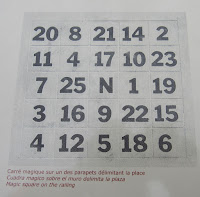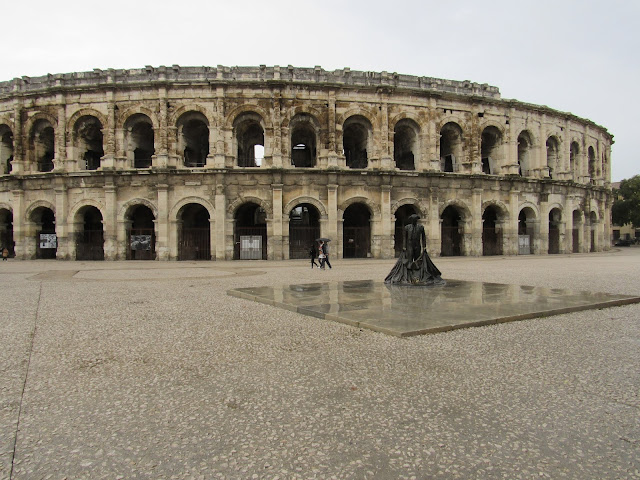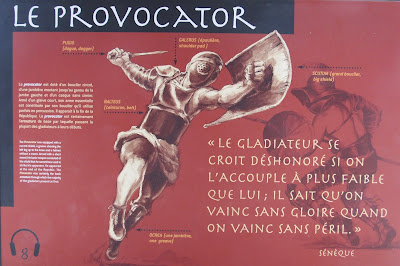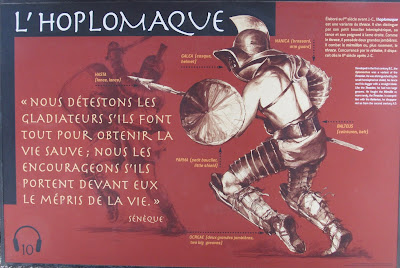 One of the first things you see after you leave the Nimes train station and walk down the long promenade is the imposing figure of the Queen of Nimes. She stands tall and proud at the top of a fountain flanked by classical lithe female and muscular male bodies reminiscent of the city's past as an important Roman city.
One of the first things you see after you leave the Nimes train station and walk down the long promenade is the imposing figure of the Queen of Nimes. She stands tall and proud at the top of a fountain flanked by classical lithe female and muscular male bodies reminiscent of the city's past as an important Roman city. 


The Esplanade Charles DeGaulle surrounds the Queen with shrubs and trees as well as small cabanas that serve food. It's a welcome and striking natural respite from concrete and stone that comprise much of the city.
 A large metal bull stands in the Esplanade to recognize the bullfighting culture of Nimes, which takes place in the Arena. Further down the street from the Esplanade is the Arena where a famous bullfighter is honored with a statue. The Arena has played host to bullfights in the past. They continue each year now. (Inside the Arena is a small display of the bullfighting tradition in Nimes. Near the Arena is an entire bullfighting museum.)
A large metal bull stands in the Esplanade to recognize the bullfighting culture of Nimes, which takes place in the Arena. Further down the street from the Esplanade is the Arena where a famous bullfighter is honored with a statue. The Arena has played host to bullfights in the past. They continue each year now. (Inside the Arena is a small display of the bullfighting tradition in Nimes. Near the Arena is an entire bullfighting museum.)War memorials can be found in most French cities. This one was particularly moving as it highlighted major battles fought during World War I in a sunken circular mosaic presentation accompanied by names of fallen Nimois carved onto the walls surrounding the mosaic. This memorial has to be one of the most elaborate in southern France. References to World War II were also added to the memorial.

A short walk to the left of the Esplanade is a plaque that memorializes the arrival of the liberating First Division of the Free French Army at the end of World War II on August 29, 1944. Soldiers fought on the battlefields of Europe and North Africa against the Nazi Armies leaving 600,000 dead.
Both a residence and an administrative building, the prefecture was a new type of building for 19th century architects. Léon Feuchère made this prestigious building a particularly large one, laid out symmetrically around a vast main courtyard, with front steps topped by a porticoed bell tower that marks the main axis and rich decorative features.

The modern Musée de la Romanité is a response to the ancient Arena, which sits opposite it on the main road near the old city of Nimes. According to the museum's website, "the two facing buildings complete each other harmoniously through their forms, lines and masses: the oval and the rectangle, the vertical and the horizontal, the density of stone and the lightness of glass. This dialogue continues inside the museum as both the façade and the glassed inner structure use transparency and a play of perspectives to show the rich heritage of Nîmes."
"Designing light architecture—made possible by present technology—seemed obvious to me, as did expressing the differences between the two architectures through dialogue based on their complementarity. On one side a round volume enclosed by the verticals of the Roman stone arches and firmly anchored in the ground and on the other a large square volume, set in levitation and draped entirely in a folded glass toga."
Elizabeth de Portzamparc, Architect
Le Petit Train takes visitors on a 45-minute city tour in English and French for only 13 Euros. (Similar tourist trains operate in several cities.) It follows the orange outline of the original city.
 French streets are never dull. There is always something going on, lots of people, and a lot of things to look at. As I sat for an afternoon coffee at the Brasserie, a sidewalk café across from the Arena, a CGT demonstration suddenly appeared on the main street. The General Confederation of Labour (Confédération Générale du Travail, CGT) is a national trade union founded in 1895 in the city of Limoges (where they make the china). It is the first of five major French trade unions.
According to historian M. Dreyfus, the direction of the CGT has been slowly evolving since the 1990s when it cut all organic links
with the French Communist Party (PCF), in favor of a more moderate stance. Since the 1995 general strikes, the CGT has been concentrating its attention on trade-unionism in the private sector.
French streets are never dull. There is always something going on, lots of people, and a lot of things to look at. As I sat for an afternoon coffee at the Brasserie, a sidewalk café across from the Arena, a CGT demonstration suddenly appeared on the main street. The General Confederation of Labour (Confédération Générale du Travail, CGT) is a national trade union founded in 1895 in the city of Limoges (where they make the china). It is the first of five major French trade unions.
According to historian M. Dreyfus, the direction of the CGT has been slowly evolving since the 1990s when it cut all organic links
with the French Communist Party (PCF), in favor of a more moderate stance. Since the 1995 general strikes, the CGT has been concentrating its attention on trade-unionism in the private sector.



Avenue Jean Jaurès in Nimes is the tree-lined boulevard that is perpendicular to the Jardin de la Fontaine. It is one of the longest promenades in France. Its modern structure is a stark contrast to the elaborate 18th century Jardin de la Fontaine, however, it has a beauty of its own. The shallow pools allow birds to stand in them without getting wet, and the babbling fountains create a tranquil ambience.
Benches in the park are also unique.
A little French history about Jean Jaurès for whom this avenue is named. Jaurès was an extraordinary man who championed "freedom of thought, resistance to outside power, love for nature and for common people, opposition to violence", according to Reuss & Reuss in their book, The Unknown South of France (1991).
Jaurés (1859-1914) started out as a teacher at the lycée in Albi and then became a professor of philosophy at the University of Toulouse where he eventually turned to politics. He won election to the National Assembly in 1885 by defeating the dominant conservative Catholics and anti-clerics, who were dominant in southern France at the time.
In 1892, after 3,000 coal miners in Carmaux went on strike, Jaurès became their advocate, which brought him to national prominence. He was an excellent orator and in 1894 with Emile Zola, became an advocate for the release of Captain Alfred Dreyfus who had been falsely accused of treason trumped up by an anti-Semitic army clique.
He fought against militarism and anti-Semitism and influenced anti-war sentiment before World War I. He founded the French socialist party, which in 1981 finally elected François Mitterand as president of the Republic. He was assassinated in 1914 in a Paris café by a right-wing fanatic because of for his anti-war beliefs.
The Clock Tower in Nimes is called the Tour de l'Horloge. It was built in the 15th and 16th centuries and is located in the Centre Ville. The square is comprised of several restaurants and boutiques, and it is one of several squares in the old city.
Some street theatre appeared in the Centre Ville one evening. It was not at all clear what these characters were, but they were fun to watch. That's what the street is all about: spontaneity, fun, openness, and performance by anyone for anyone.


Sources
Nimes Office of Tourism
The Unknown South of France: A History Buff's Guide. Henry and Margaret Reuss (1991). Boston: The Harvard Common Press.
























































